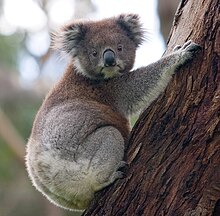Overabundant species
In biology, overabundant species refers to an excessive number of individuals[1] and occurs when the normal population density has been exceeded.
Overabundance may occur naturally, for example after weather events such as a period of high rainfall[3] in which habitat conditions become optimal.
[4] Other human disturbances include restrictions on hunting, agricultural land modification[5] and predator removal or control within a region or area.
[3][6] The consequent change in land use and the presence or withdrawal of human influence can trigger a rapid increase in both native and non-native species populations.
This occurred for the Bettongia lesueur, the burrowing bettong, which was reintroduced to the Arid Recovery reserve in Australia: their population has increased from 30 to approximately 1532 individuals.
[9] Overabundant predators are considered harmful to local biodiversity as they prey on native species, compete for resources and can introduce disease.
They can decrease native mammal populations and, in some cases, can cause species to become extinct which results in a cascading ecological impact.
[12] In general, invasive species that become overabundant most commonly have a negative impact on local biodiversity[12] with little research having found positive effects.
The established population has thrived in previous years due to the following factors: adaptability to climate conditions, the ability to live in a wide range of habitats including deserts and forests, and lastly human modification of Australian landscapes which are suitable environments for red foxes to thrive in.
[13] The diet of red foxes include a number of threatened native fauna which has contributed to their population declines and extinctions.
This method allows a large number of animals to be eliminated within a relatively short amount of time, however shots are not always accurate which can lead to the escape and suffering of individuals.
Fumigation, which involves the spreading of poisonous gas, helps to selectively kill a large number of animals.
It is a method used to control rabbit and fox populations in Australia by spraying a lethal chemical into warrens and dens.
[17] Two methods for managing fertility in overabundant wildlife include the employment of biotechnology such as immunocontraception, and surgery to neuter males or spay females.
Studies have been conducted on various animals, for example white-tailed deer and cats, of which have shown that GnRH can be effective in reducing short term fertility.
[24] This method can be effective in small populations as it is fairly accessible, however the procedure is costly, invasive as well as the individual being at risk of infection after surgery.
Surgical sterilisation is permanent, as a result it may not be appropriate for use in native populations due to the risk of potentially losing genetic variation.

